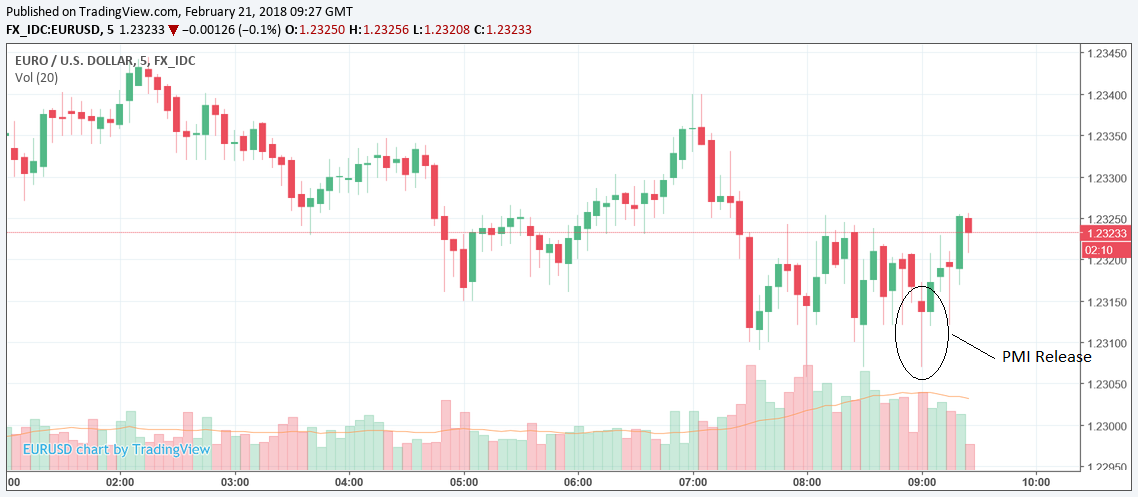Eurozone PMIs Confirm Eurozone Growth Hits the Speed Limit

© freepeoplea, Adobe Stock
Eurozone manufacturing and service sectors continue to grow at an impressive pace, but a speed limit might have finally been reached.
European business survey data out on Wednesday, February 21 show growth in the Eurozone's manufacturing and services sector came in below analyst expectations bringing to an end a multi-month run of consensus-busting results.
The data came as a surprise to some given both sectors' meteoric rise in 2017, and analysts are now asking whether growth in the Eurozone has reached its 'speed limit'.
The data raises doubts about the continued outperformance of the Euro which has been one of the best performing global currencies of recent months thanks to the region's ability to deliver positive surprises when it comes to growth data.
Eurozone Manufacturing and Services Purchasing Manager Indices (PMI) are composed by financial information provider IHS Markit; they are surveys which ask key managers in business and industry about how their sector is progressing.
The data is considered a reliable forward indicator of growth so the market generally reacts quite rapidly to it.
Today's data say Manufacturing PMI in February slow to 58.5 from 59.6 in January (a 4- month low) and Services reduce to 56.7 from 58.0 (a 2-month low). The Composite of the two PMI fell to 57.5 from 58.8.

Although any reading over 50 suggests expansion and the readings started from a high level, this is the second month in a row the metric has shown slowing activity.
Nevertheless, Markit remained upbeat in their accompanying report:
"Eurozone business activity continued to rise at a steep pace in February, albeit with the rate of expansion cooling from the near 12-year high recorded in January."
The report's subcomponent results suggested the slowdown in the headline figure did not translate into substantially lower inflation pressures.
"Price pressures and employment growth also remained elevated, though likewise saw rates of increase ease slightly," says Markit.
This may explain why the Euro did not weaken very much after the release, despite the data missing the expected figure.
Inflation is the primary factor which informs Eurozone monetary policy.
The Euro has risen on expectations that the European Central Bank (ECB) will wind down its stimulus programme and starts to raise interest rates.
Higher interest rates are generally positive for a currency as they draw greater foreign capital inflows due to the higher return on offer.
The single currency's response to the PMI data, therefore, was muted with EUR/USD taking a step back on the 5-minute chart only to rebound after a while.

EUR/GBP meanwhile saw no downside for the Euro whatsoever.

The slowdown did not come as a surprise to analysts at Danske Bank who are more circumspect about the sustainability of Eurozone growth and had foretold the lower result in their data preview several hours before the release this morning:
"In the euro area, February's PMI figures are due for release. Manufacturing PMI saw a large fall to 59.6 in January and the leading order-inventory indicator has been declining since October 2017, pointing towards lower manufacturing output in the near future, while the extremely high optimism for the manufacturing sector is likely to be exhausted and head to lower levels. We expect manufacturing PMI to be 59. 3 in February and believe that service PMI is also set for a similar decline to 57.6."
After the release Danske tweeted their reaction, included below:
We had almost gotten used to #Eurozone releases surprising to the upside last year. However, as we have pointed out Economic surprise indices were set to fall => today's #EUROAREA #PMI releases (red) fall short of expectations (green) even if the level remains high. pic.twitter.com/ZBreCqvTD0
— Danske Bank Research (@Danske_Research) February 21, 2018
Less pessimistic about the longer-term outlook for growth despite the steep pull-backs in the last two months, is IHS Markit Chief Business Economist Chris Williamson who highlights robust business optimism as one indicator the outlook may recover.
“It remains to be seen if growth will continue to slow in coming months. However, a rise in business optimism about the year ahead to a joint-survey high bodes well, suggesting that companies are expecting the slowdown to be short-lived," says Williamson
Get up to 5% more foreign exchange by using a specialist provider to get closer to the real market rate and avoid the gaping spreads charged by your bank when providing currency. Learn more here.









